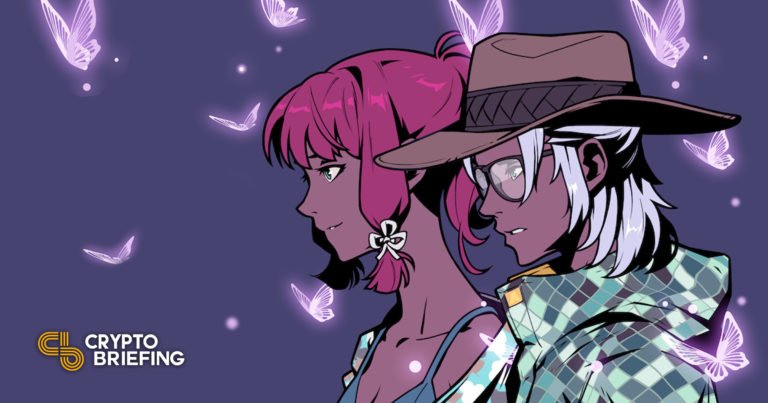
Key Takeaways
Azuki is an NFT collection of 10,000 anime-inspired avatars that reached the absolute peak in popularity in 2022 before falling from grace.
The reason for the downfall was a single mistake from one of the project’s founders, Zagabond, who naively ousted himself as an opportunistic leader of three past failed NFT projects.
The record-high floor price of Azukis reached $115,000 in April. Today, it’s about $12,000, marking an almost tenfold drop from the top.
Share this article
Despite hundreds, possibly thousands of NFT projects launching since the NFT avatar scene exploded in early 2021, not too many went from zero to hero, and even fewer circled all the way back. Azuki’s story is one of those: one of reaching the absolute heights of hype and falling to relative mediocrity.
The Rise
Launched in January 2022 by four anonymous founders, Azuki was one of the few avatar NFT collections that everyone believed had done everything right. The execution on Chiru Labs’ part, the startup behind Azuki, was so good that many quickly became convinced the project could turn out to be “the next Bored Ape Yacht Club”—then and still the most prized NFT collection in the nascent industry. Christian Williams, the Editor-in-Chief at Crypto Briefing, wrote a column in April praising the collection and advising teams that hoped to create the next six-figure blue chip avatar to take note of Azuki’s superb execution.
And back then, he wasn’t too far off the mark. Azuki’s art was—and still is—a cut above the rest. The lore: top-notch. The community was vibrant and growing. The roadmap, or as Azuki called it, the “mindmap,” was promising and well thought-out, but perhaps most important, it existed. Many NFT collections of the kind don’t have a roadmap at all, let alone a team capable of executing it. Azuki seemed to have it all and was lucky enough to receive community recognition. The 10,000-item collection sold out on release, minting for about 1 ETH apiece. Sales on the secondary market immediately began ramping up, reaching a floor price of about 7 ETH in only days following release and about 15 ETH by the month’s end.
By mid-March, the collection’s floor price tanked to about 9 ETH, with interest slightly waning off, but then Chiru began delivering surprises the community couldn’t get enough of. On Mar. 30, the team airdropped 20,000 “something” NFTs to Azuki holders, rekindling massive interest from speculators in both the collection and the airdropped somethings. A day after the drop, the unpacked digital presents—later unveiled as Azuki sidekick avatars dubbed BEANZ—reached a floor price of about 3.14 ETH, putting the cumulative value of the airdrop at over $213 million. This equated to a payout of around $21,000 for each Azuki avatar collectors held.
In the leadup to the airdrop, the collection’s floor prize doubled from around 9 ETH to about 18 ETH, and in a few short days following the drop, it almost doubled again, reaching about 34 ETH, then worth approximately $115,000. In April, the skaters of the Internet were at the peak of the hype ramp, doing Bean Plants and drawing awe and applause from most of everyone in the digital collectibles community. It was then when chatter that Azukis could reach blue chip status and even potentially flip BAYC began ramping up on NFT Twitter. The floor price of BAYC in April went from around 110 ETH to its record-high price of around 155 ETH, while Azukis were trading at roughly 30 ETH. Yet still, talk of the flippening was ongoing, and many collectors seemed to believe it.
However, that was until one of Azuki’s anonymous founders, going under Zagabond on Twitter, naively decided to make a grave blunder: talk about his past failures.
The Fall From Grace
On May 9, Zagabond published a blog post titled: “A Builder’s Journey.” In it, he opened up about his past failures in the NFT space and outlined some of the lessons he learned in his journey. “During these formative times, it’s important that the community encourages creators to innovate and experiment. Additionally, each experiment comes with key learnings,” he said.
While his intentions may have been pure, in hindsight, it was one of the worst mistakes Zagabond could make, as it only tarnished the impeccable brand Azuki had built thus far by linking it to fraught projects that many in the community subsequently went on to label as outright scams. He revealed that he had led CryptoPhunks, Tendies, and CryptoZunks—three NFT projects that would eventually fade to black.
CryptoPhunks was hit with a Digital Millennium Copyright Act (DMCA) takedown request by CryptoPunks—the first NFT collection to reach blue chip status—after which Zagabond was forced to abandon it. But he did not do it without first making bank, as one Twitter user pointed out. According to on-chain data, months after CryptoPhunks went bust, its creator executed a “wash trade” on the NFT marketplace LooksRare for a profit of 300 ETH after increasing the creator royalty rate to 5%. Wash trading is a form of market manipulation executed to artificially inflate trading volumes for a specific asset. It is illegal in traditional markets, as spiking trading volumes could mislead investors into thinking there’s a genuine interest in the asset.
Zagabond’s second NFT experiment, Tendies, failed from the get-go, with only 15% of the collection minted at launch. However, one collector going by 2070 on Twitter pointed out that Tendies was effectively a rug pull. According to the anonymous collector, who allegedly participated in the Tendies mint, the project ceased all activity post-launch, abruptly deleted all social media, and closed the Discord channel within a month of the mint.
With CryptoZunks, Zagabond was ousted for engaging in questionable behavior to promote the project on social media. Ahead of the launch, he allegedly posed as a woman named Amanda and used a female CryptoZunk profile picture on Twitter. To many observers, Zagabond outed themselves as an opportunistic NFT founder that hopped from one project to the next with little regard for investors until he struck gold.
To top it all off, when Zagabond did strike gold with Azuki, he somehow managed to turn it into lead by severely damaging the project’s reputation. In the days following the publishing of his blog post, Azuki’s price floor more than halved, plunging from around 20 ETH to about 7.5 ETH.
The State of Play
While many NFT projects have come and gone over the last year, the Internet skaters’ fall from grace will likely remain inked in the NFT history books as one of the worst in history. Not because Azuki hit an absolute bottom—far from it—but because it was one of the only projects that at least looked like it had a genuine chance of overthrowing the two industry darlings, CryptoPunks and Bored Apes.
And while Azukis still command a hefty price, with the collection remaining the eleventh-largest by total market capitalization, their downfall—as measured from their record to their current price—is difficult to overstate. At their all-time highs, Azukis’ floor price was around $115,000. Today, it’s about $12,000, marking an almost tenfold drop from the top. For comparison, CryptoPunks and BAYC fetched around $440,000 and $435,000 at their all-time highs, and today they trade for about $127,000 and $114,000, respectively.
The silver lining in this story is that Azuki’s decline can be used to teach NFT collectors a valuable lesson: every reputation-based project, even the most promising one, is one naive mistake from fading into obscurity.
Azuki’s story is not finished, and collectors may very well witness a redemption arc, but the age-old adage still applies: reputation is like a house of cards—it takes a long time to build and is quickly blown away.
Disclosure: At the time of writing, the author of this feature owned ETH and several other cryptocurrencies.
Share this article
The information on or accessed through this website is obtained from independent sources we believe to be accurate and reliable, but Decentral Media, Inc. makes no representation or warranty as to the timeliness, completeness, or accuracy of any information on or accessed through this website. Decentral Media, Inc. is not an investment advisor. We do not give personalized investment advice or other financial advice. The information on this website is subject to change without notice. Some or all of the information on this website may become outdated, or it may be or become incomplete or inaccurate. We may, but are not obligated to, update any outdated, incomplete, or inaccurate information.
You should never make an investment decision on an ICO, IEO, or other investment based on the information on this website, and you should never interpret or otherwise rely on any of the information on this website as investment advice. We strongly recommend that you consult a licensed investment advisor or other qualified financial professional if you are seeking investment advice on an ICO, IEO, or other investment. We do not accept compensation in any form for analyzing or reporting on any ICO, IEO, cryptocurrency, currency, tokenized sales, securities, or commodities.
See full terms and conditions.
















